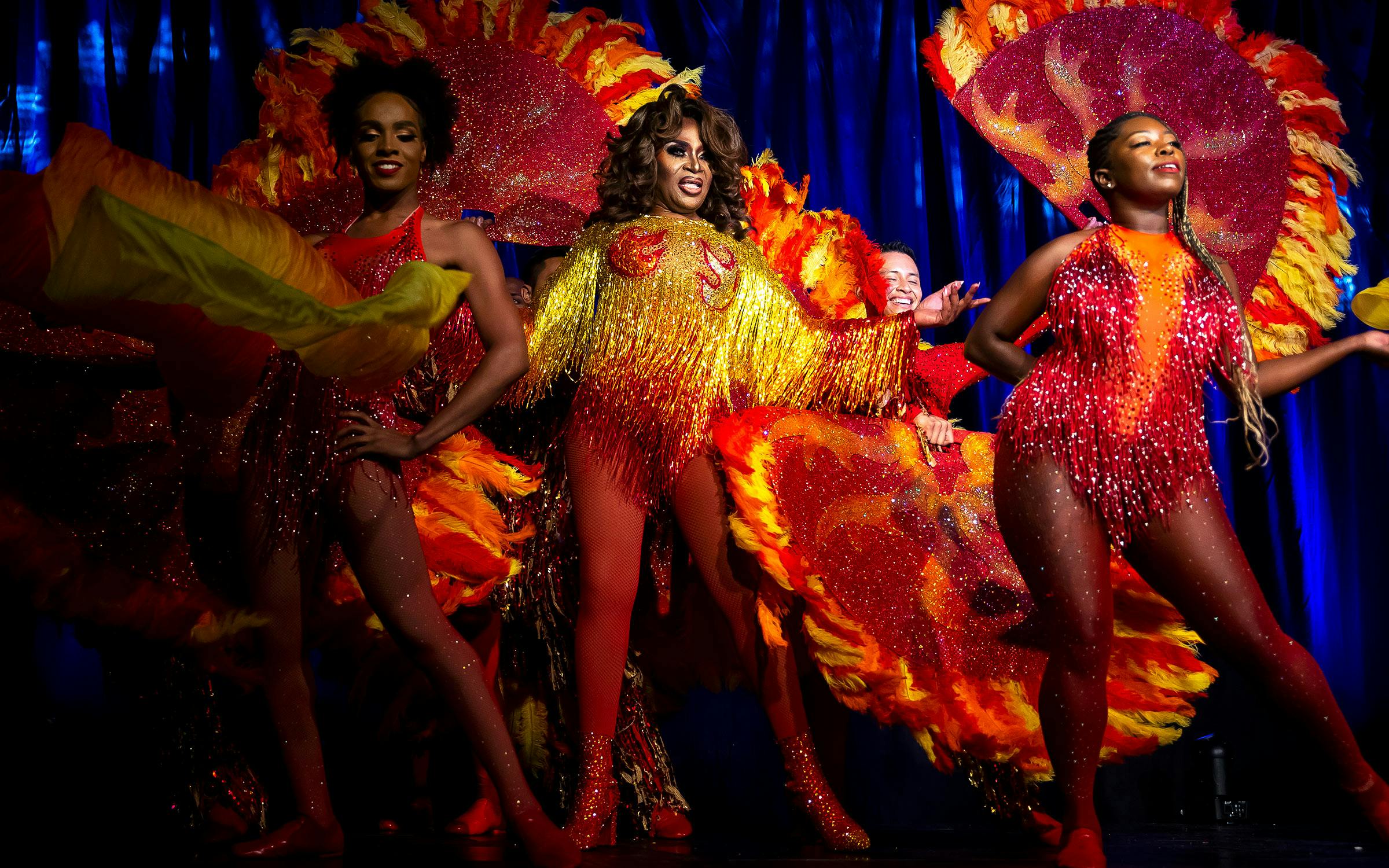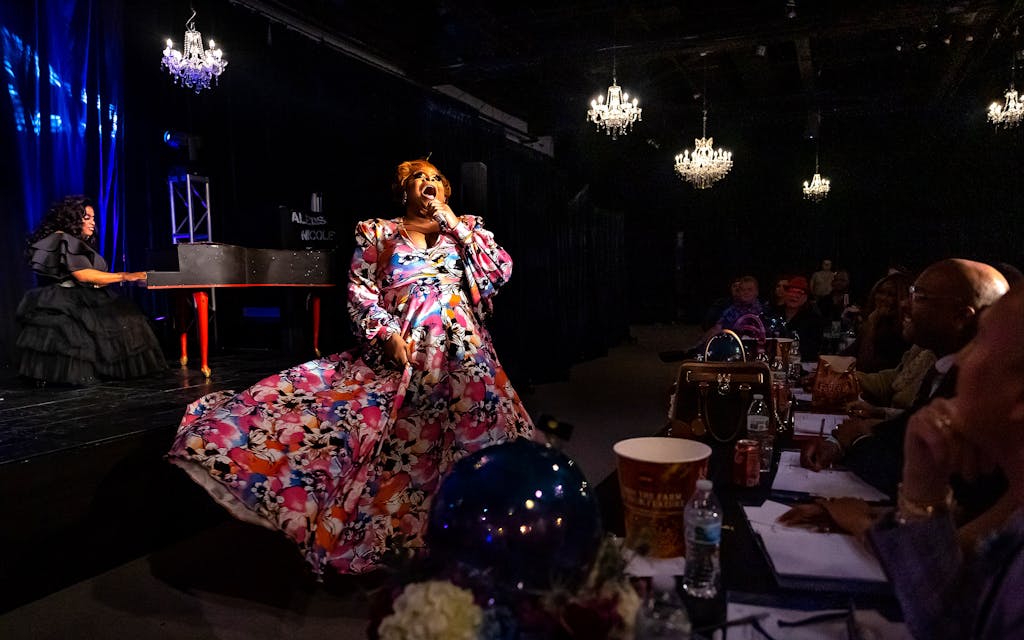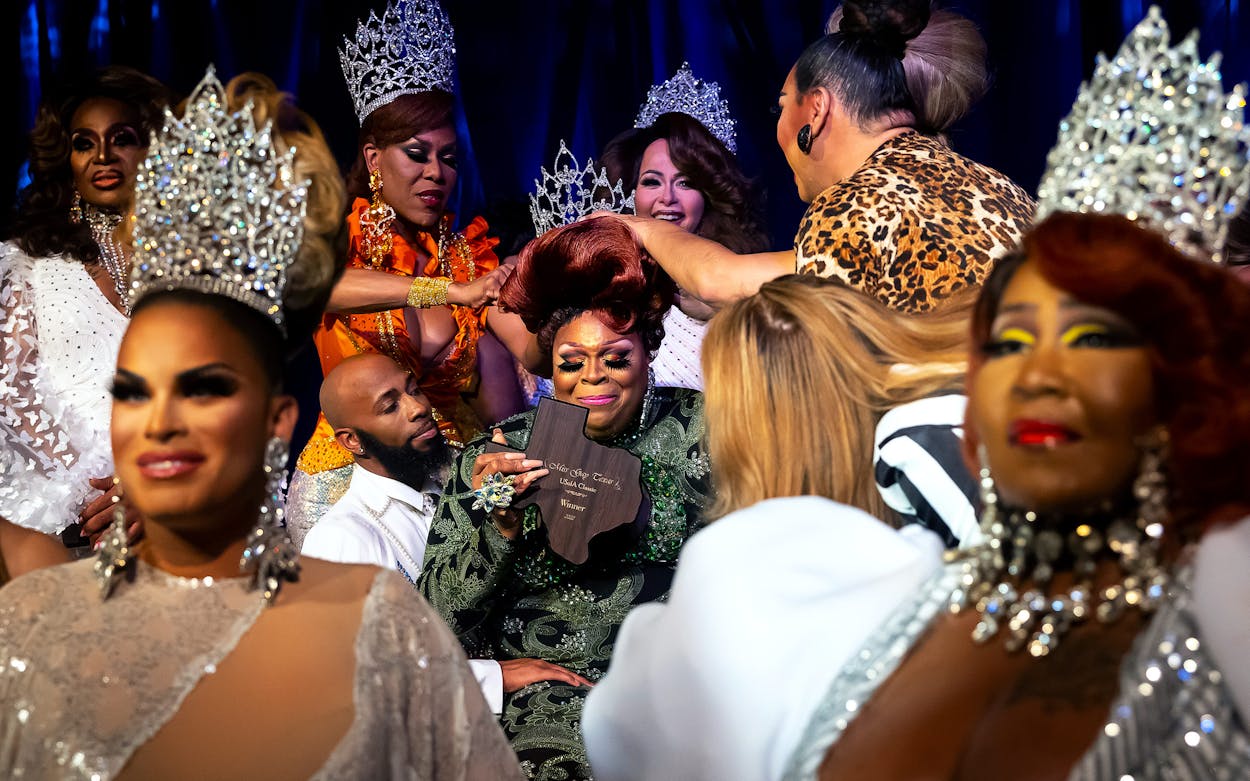Before Vivica Perry, the reigning Miss Gay Texas USofA Classic, can take the stage for the opening number, there are sequins to glue, nerves to quell, and rings the size of teacup saucers to slip onto manicured hands.
In a large downstairs space beneath the chandeliered Ballroom at Bayou Place in downtown Houston, Regina Dane, Symphony McKnight Capri, and Topaz sit patiently in their makeup chairs. The eleven pageant contestants don silk robes or wraps as makeup artists apply lashes, blot lipstick, and unleash lethal bursts of hair spray. Tangerine tulle capes and ruby-red sequined dresses spill out of hanging bags, telegraphing the glamour to come. Then there are the museum-worthy wigs that, even on their stands, look like priceless works of art. How the contestants will manage to lip-synch, dance, and remain poised and elegant with these closer-to-God structures on their heads is beyond me, but that’s part of the magic of drag. Unlike the Miss America and Miss Congeniality stereotypes of pageants past, this contest isn’t about teeny bikinis or outdated “social graces.” Like recent Miss Universe pageants, where contestants have held up signs reading “Pray for Myanmar” and promenaded in rainbow skirts in support of LGBTQ rights, it’s not about fitting any sort of standard, patriarchal mold. This nine-inch-tall crown—bigger than the ones on the heads of Miss America or Miss Universe—goes to the contestant who sashays onstage exemplifying boldness, confidence, elegance, and, perhaps the most important quality of all, an element of surprise. Of course, a resplendent evening gown doesn’t hurt.


For over 35 years, the Texas USofA Pageants system has been a place for LGBTQ Texans to shine. According to codirector Kofi, the recipient of many crowns and a grande dame in the drag world, the organization plans to carry on the tradition for decades to come. The Classic pageant, which is celebrating its eighteenth year on this April afternoon, is for contestants forty years old and over. It’s part of a pageant system that also includes Miss and Mr. Gay Texas USofA, Miss and Mr. Gay Texas USofA at Large, and Miss Gay Texas USofA Newcomer. When beloved pageant promoter Craig Henderson passed away unexpectedly in August 2021 due to complications from COVID-19, Kofi (pronounced “coffee”), Kelexis Davenport, and Erick Castillo (a.k.a. Kayla Monroe) of event-promotion company K3 Entertainment were chosen as his successors. They worked day and night to put on a show that would carry on Henderson’s legacy of world-class pageants throughout Texas. “We do a lot of conference calls at three in the morning,” Kofi had told me on a Zoom call a few weeks earlier. Organizing one of these pageants is a round-the-clock job. There are always decisions to make and questions to answer. The responsibility to keep the tight-knit community that Henderson fostered thriving, especially during a time when queer rights in Texas are under siege, is not lost on the organizers.
“The road of this female impersonation can be incredibly taxing on your spirit and on your psyche,” Davenport says. “Sometimes when you just have a knot in your rope of support it makes life a lot easier.”
Upstairs in the ballroom, guests of all ages trickle in, including Texas drag legends like Tommie Ross, a Houston-based pageant queen and winner of titles like Miss Black America, Miss Gay USofA, and Miss Continental. She’s a mentor to others and a longtime advocate for transgender rights in the state. To Ross, the pageants are vital, not just for the community, but also for Texas culture at large.
“This is an avenue for LGBTQIA+ people to show their talent and uniqueness,” Ross says of the pageants, which are open to any Texan 21 or older who was assigned male at birth. “It’s a safe space where you can come and be free and unapologetically yourself, especially with all the rollbacks happening in Texas right now.”
Dallasite Adam Beale, a close friend of the pageant promoters, including the late Henderson, agrees. Beale knows everyone at the show, and he’s brimming with the inside scoop on what goes on behind the scenes. “This is such a loving space,” Beale says. “Some kids in the gay community are shunned by their families, so drag queens are the mothers. It’s a chosen family. I’m Kofi’s daughter, even though I don’t do drag.”
Despite the intentions of certain lawmakers, the Texas drag community has come a long way. It’s unusual to have a drag show in the afternoon, Beale says. “Prior to us, these shows were in gay clubs at night and people were hanging over the railings. Now it’s sophisticated.”

He introduces me to previous Classics Iroc Octavia Goodness from Fort Worth, Layla LaRue of Dallas, and Houston’s Flawless Oz, who sit in a row chatting as they expertly apply foundation and blush. They aren’t competing today, but they’re here to perform and pay homage to the long line of Classic pageant queens past. “Texas has some of the best drag queens ever,” Beale whispers as he leads me down a hallway, where I meet contestant Alexis Nicole Whitney, who lost her sight to meningitis in her early twenties. Her talent portion will bring the house down later that afternoon, but at the moment, neither of us knows what the day will hold. For now, Whitney is getting prepped in a makeup chair, just like everyone else. Contestant Poison Alexander Dior flew her makeup artist in from Jacksonville, Florida, she says, “to work her magic.” Dior took fifteen years off from pageantry to focus on her education and career, but she’s back to reclaim her dream of becoming Miss Gay Texas USofA Classic.
“I’ve been prepping for two years, and I want to give it one more try,” she says. “Once I got everything perfect, or my definition of perfect, I said, ‘Okay, I’m ready.’ This takes passion, determination, and focus.”
Dior’s version of perfect, on full display in the evening gown portion of the pageant, includes two men in suits and bright orange bow ties, who pull off her stunning tangerine cape to reveal an orange-and-silver, formfitting, crystal-and-bead-encrusted gown. Her matching earrings are the size of long-stemmed wine glasses, and she wears a blond wig shaped and molded into shiny 1940s victory rolls, with a wave up top that reaches to the heavens.
At a long table in front of the stage, a panel of seven judges, including Alexandria C. Scott, a lawyer and former Miss Black Texas USA, Jovon Tyler, president of the Houston LGBTQ+ Political Caucus, and former Classic Nancy Taylor, sit ready to judge the evening gown and talent competitions. Contestants are also judged on a seven-minute interview, during which they’re asked about their reasons for competing and what winning means to them. The winner receives a $600 cash prize, the crown, and the opportunity to travel the state of Texas as the current queen for the Classic division. She also qualifies to compete in the national pageant, Miss Gay USofA Classic, in May. Another major plus is that the title helps drag performers command more pay from bar and club owners, since the designation draws crowds.


The gleam of the crown and the chandeliers had already seemed impressive just an hour before, but the capes, dresses, jewels, fans, and fringe parading across the stage during the evening gown segment make the neon lights of Las Vegas look like a dust bowl. At this show, feathers are not just feathers, sequins are not just sequins, and shoes are not just shoes—they are extravaganzas of glitz and scale. By the end of the night, I am hallucinating sparkles. Does guest performer Mon’Terio J. Ross, Mr. Gay Texas USofA 2021, have actual glitter in his beard? Are contestant Symphony McKnight Capri’s teeth shining? On that stage, anything is possible.
At last, Davenport announces that it’s time for the talent competition. “Sponsored by Men’s Wearhouse!” she jokes. There are no earnest poetry readings or amateur ventriloquism at this talent show. This is high kicks and high drama. It’s Adeciya Iman leaping into the splits, accompanied by school-age kids from her dance troupe, Dynamic Divas of Houston. It’s sixty-six-year-old Topaz, twirling expertly in heels, and legally blind Alexis Nicole Whitney coming on stage without makeup, sitting at a makeshift vanity, and lip-synching while applying a full face of foundation, gloss, and contouring without missing a beat. Beale leans in and reminds me that the act that brings the audience to its feet isn’t always the one that wins. The judges look closely at technique and precision, not just at the wow factor. The Classic pageant in particular implodes the outdated notion that once a woman reaches “a certain age,” her place is in the seats and not in the spotlight. Age, on this stage, is an asset.
When the talent portion comes to a close, it’s time for the judges to get to work. Then Kofi, Kelexis, and Kayla tally the results backstage. The guest acts continue, and as audience members walk to the stage to tip the performers, their admiration and respect for the entertainers practically beams from their faces. It’s a loving, supportive environment that feels worlds away from the hostility and transphobia happening in so many spaces outside these doors.
At last, reigning queen Vivica Perry takes the stage for her final performance as Miss Gay USofA Classic. She’s wearing a white evening gown and her bejeweled, nine-inch-tall crown as she runs through a medley of songs that include George Michael’s “Freedom! ’90” and Prince’s “I Would Die 4 U.” She sobs throughout the performance. Kofi, wearing one of her signature “short, sassy wigs” and a red off-the-shoulder dress, leans in and whispers in my ear, “We might have to cut her off. Sometimes they get a little carried away.”

When Vivica finishes lip-synching, contestants and past Classics walk onstage together so the runners-up and winners in each category can be announced. Alexis Nicole Whitney wins the interview portion, and Poison Alexander Dior takes the evening gown points. The 2022 Miss Gay Texas USofA Classic crown goes to Symphony McKnight Capri, who takes her Texas-shape plaque, dons her tiara, and cries.
As for Kofi, Kelexis, and Kayla, tonight’s show might be winding down, but there are upcoming pageants to plan, and more 3 a.m. conference calls to attend. They have a bevy of pageants to put on throughout the state over the next few months, leading up to the main event in August back at Bayou Place, Miss Gay Texas USofA.
On our Zoom call a few weeks before the event, Kofi had told me that at a pageant she once performed in, a young man came up to her after the show and told her that something she said gave him a reason to live, to not take his own life. Moments like that are why she keeps working as hard as she does to create those safe spaces, the rooms full of chandeliers and tulle, and, above all, love and support.
I asked Kofi what she said that night that touched the young man so deeply. “I can’t remember,” she tells me, “but whatever I said, I thank God for it.”
- More About:
- Style & Design
- Houston






